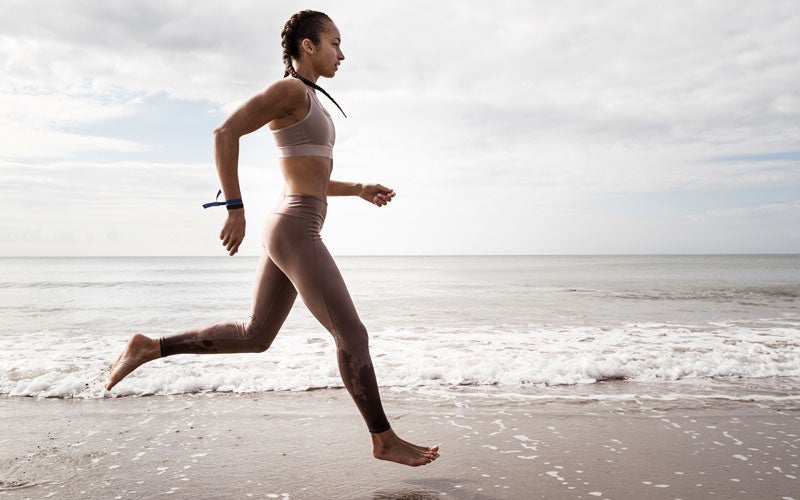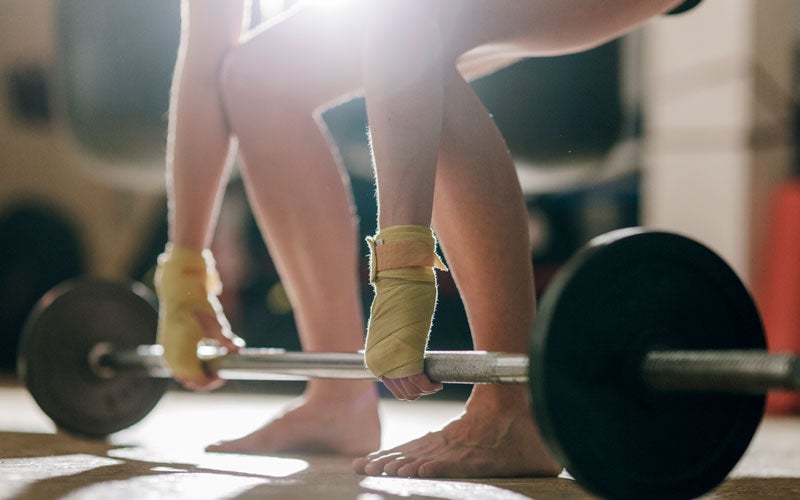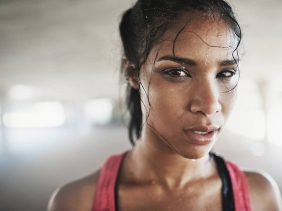Barefoot Running: Your Feet Are the Best Shoes
 ©Igor Emmerich
©Igor Emmerich
Barefoot running is becoming trendy for good reason. If you’re curious about this type of workout, keep reading to find out why it can be beneficial and what effects it can have on your body.
There’s no denying that it can feel really good to run barefoot. Especially on warm days when there’s no risk of running through a puddle of rain water or a mountain of snow, it can be a thrill to feel freshly cut grass or warm sand between your toes. Even if you live in a city, it can be so nice to head to a park and let your feet breathe the cool, open air.
Aside from creating the sensation of being on vacation, running without shoes can improve muscle strength and the quality of your movements. Because your feet are connected to your calves, hips, lower back, and upper body, running without shoes can affect the health of your entire body.
The benefits of barefoot running
Walking or running without shoes engages your entire musculoskeletal system. Plus, it can have some serious health benefits.
Running barefoot…
- strengthens foot muscles.
- engages ligaments and tendons.
- improves coordination.
- stabilizes ankles and minimizes risk of injury.
- prevents foot malpositioning and subsequent orthopedic problems.
- engages calf muscles.
- promotes a healthy stride.
- promotes static body balance and can help reduce knee and back pain.
Though it may seem counterintuitive, running barefoot is not likely to cause bunions to form on the bottoms of your feet. Bunions form as a result of friction between feet and shoes. The reason your feet may feel less sensitive to heat and pain after spending some time barefoot is because a thicker layer of fat has developed under the skin. In the end, your feet will be both stronger and more supple.
Is barefoot running good for your health?
Yes, running barefoot is good for health. Have you ever noticed that when you run without running shoes you almost never twist your ankles? That’s because your feet are doing their job perfectly. Our feet have evolved to have receptors that signal to the muscles, joints, and tendons exactly how to react to restore balance.
When you’re not in shoes, your feet stay in shape because they have to work constantly. With shoes on they can relax much more, which actually weakens your foot muscles and coordination over time.
Wearing shoes all the time often leads to flat or deformed feet. This can negatively impact leg shape and lead to hip and back problems.
However, that’s not a free pass to only run barefoot from now on. If you’re used to being in shoes the majority of the time, your feet will need time to gradually adjust to these new demands.
When is it not a good idea to run barefoot?
People with diabetes may want to avoid running barefoot because of something called diabetic foot syndrome. This can negatively impact the nerve endings in the feet and block the transmission of stimuli to the brain. They may not feel pain immediately, but they will feel it later. And because it takes longer for people with diabetes to heal, this can be extremely detrimental.
Patients with osteoarthritis should also get their doctor’s approval before going barefoot, because it can further aggravate the pain that the disease already causes.
Barefoot running technique
Feet function differently with and without shoes. The difference will come down to your running style and will be determined by which part of your foot touches the ground first.
In general, there are three types of strides: heel, midfoot and forefoot. These strides challenge your feet in completely different ways.
The heel strike
The greater the difference in height between the front and back of the foot, the more likely the heel is to hit the ground first—especially when running quickly. Your heel cushions the impact on the ground and that gives your feet muscles little to do, resulting in a strain on your knees, hamstrings, and lower back.
The midfoot stride and the forefoot strike
Both of these strides start with a runner placing their forefoot or midfoot on the ground. The forefoot strike requires more effort from your calves than the midfoot stride. However, both styles greatly engage the muscles in your feet.
As soon as your foot hits the ground, all of your muscles, tendons and ligaments are working quickly so that you land smoothly, steadily, and securely. The less cushioning your running shoes have, the harder your foot muscles have to work.
Barefoot running promotes a natural running technique
Barefoot running forces you to adopt more natural running habits. That’s because most of our ancestors spent their days running barefoot while hunting prey and foraging for food. Strong feet and healthy bodies are some of the central factors that allowed our species to evolve to its current state. Running without running shoes recalls these ancestral habits.
The Anatomy of a Foot
Because your feet carry the entire weight of your body, they’re constantly on the job. Here, we explain a little bit about what makes them so special.
Feet: small but complex
Feet are intricately designed to get us from point A to point B. They contain more than 60 muscles, 26 bones and joints, and over 200 tendons, as well as thousands of nerve endings and receptors that transmit information to the brain.
Healthy feet: the basis for movement
When running barefoot, it’s important to use every part of your feet—including your toes! All the different parts need to work together to ensure smooth movement.
The transverse and longitudinal arches in your feet are responsible for creating stability and providing support. If your feet are constantly trapped in shoes, the muscles in these arches may weaken and collapse over time.
Splay feet happen when the transverse arch collapses. Valgus feet happen when the longitudinal arch collapses. These foot deformities can influence your overall movement and affect the shape of your legs, knees, hips, lower back and even your neck.
7 Steps to Start Running Barefoot
Though we’ve talked a lot about the benefits of running barefoot, there is still some value to wearing shoes. In everyday life and in sports, they can prevent injuries and keep your feet warm in cold weather. It’s important to find the right balance between “with shoes” and “without shoes”.
Step 1: Start off slow
Before you can fully embrace barefoot running, your feet need to adjust to the new challenge. Start by walking barefoot at home. Try to spend at least 30 minutes a day without shoes on. Overdoing it right away will put you at a greater risk of developing an injury, including stress fractures.
Step 2: Choose a soft surface
As you become more comfortable without shoes at home, take the opportunity to occasionally remove them outside. Go for a short run on grass, walk a few yards on the beach, or take a lap around a tartan track. Whatever you do, make sure you’re starting your outside barefoot experiments on a soft surface. Soft surfaces allow your feet to develop balance, coordination, and strength.
Step 3: Find a barefoot course
Many cities have barefoot running paths made from different materials to stimulate your feet in various ways. You’ll usually find these paths in the middle of nature, which makes them a great place to do a little meditation and stop to smell the flowers.
Step 4: Train your Achilles tendon
The Achilles tendon is the most powerful tendon in your body. It transmits strength from your calf to your foot and you wouldn’t be able to stand without it. Running without shoes naturally engages and reduces the risk of inflammation of this tendon.
Our tip: Squats are a great way to strengthen your Achilles tendon and prepare your body for running barefoot.
Step 5: Move your toes
Wiggle your toes one at a time to prepare your feet for barefoot running. Lift your big toe while the others are still planted on the ground. Then keep going one toe after the other. This is a little workout you can even do while you’re sitting at your desk.
What it does is strengthen the flexibility of the plantar tendon and develop targeted control in each separate foot muscle. The plantar tendon runs along the longitudinal arch under the sole of the foot and is just as responsible for movement as the Achilles heel.
Step 6: Practice stability exercises
Stabilization exercises improve foot and leg strength as well as coordination. If you’re interested in barefoot running, start by practicing our 15 stabilization exercises for runners until you can do them without any problems. They’ll get your feet ready for barefoot running in no time.
Step 7: Don’t overestimate yourself
Constantly wearing shoes weakens your feet, which is why it’s good to start running barefoot slowly. Think back to your first gym session. Did you work out every single day of the week? Probably not.
Though it might not seem like your feet need as much training as other muscle groups, they do. They also require time and practice to successfully adapt to new movements, techniques, and efforts. Like other muscles, they need recovery time, too!
Is working out barefoot good for health?
Barefoot running can be great for health but only if you incorporate it slowly and carefully into your life. Once you’re able to walk around all day in flimsy sandals without problems, you’re probably ready to give it a go.
Our tip: Before diving in, consult an orthopedic doctor or an experienced trainer to find out if this type of activity is right for you.
Are barefoot workouts healthy?
Barefoot workouts strengthen your feet. But don’t make the best the enemy of the good. Start by going short distances—often much shorter than you think. You’ll notice more fatigue in your legs than in your feet.
If your arch muscles aren’t sufficiently absorbing the shock of a landing, tiny fractures may begin to appear in your metatarsal bones. Take precautions to ensure this doesn’t happen, because it can be difficult to fix once it does.
Start by trying to run without shoes for only 200 meters before returning to your shoes. A few days later, try advancing to 250 meters. The important thing is to build up gradually over time.
Prefer to keep your shoes on? Use our tips to find the best running shoes for your feet. Still looking for the perfect running shoes? Find out here how to find the right shoes for you.
Don’t release the tension in your body when working out barefoot!
At the gym, it’s better to wear minimalist shoes than go completely barefoot purely for hygienic reasons. During HIIT or weight training, it’s important to contract your body even more if you’re not wearing strong shoes.
As always, it’s best to start off slow. Without shoes, your feet have to work harder. You may have to reduce the overall intensity level of your session, but your feet will be stronger and healthier as a result.
For HIIT, and especially for exercises that involve hip work, try to be as gentle as possible. In order to do that, activate your chest muscles. This will better enable you to control your movements and shift the weight from your feet.
Are you trying to develop your upper body muscles? Perfecting your push-up form will help you do just that.

In strength training, always double check your foot position before beginning another rep. Is your body weight distributed evenly throughout the foot? Are your knees facing outward? Let your feet take an active role in the exercise.
Our tip: Though exercising barefoot can be good for your health, there’s also a time and place for shoes. During an intensive workout, they can provide your feet with a lot of support.
In general, continue to use your favorite pair of shoes for intense workouts and try to use low-intensity barefoot exercises as a complement to your usual physical practice.
Can I run barefoot in winter?
Whether or not you can go barefoot in the winter will depend on how sensitive you are to cold temperatures, where you live, and how long you plan to run for. Cold weather won’t necessarily make you sick. In some cases, it may actually strengthen your immune system.
If you want to train without shoes in winter, try to do it only as long as you can stand it. Your feet will automatically warm up as they work. If it’s really cold out and there’s a layer of snow on the ground, you’ll likely be able to go for about 2 to 5 minutes.
On the other hand, it’s important to make sure your feet aren’t cold and wet during your entire run. Take time to dry them off and warm them up whenever you get a chance.
When in doubt, it’s never a bad idea to run barefoot indoors. Yoga or short bodyweight exercises are also great opportunities to kick off your sneakers. Running barefoot indoors is always a good idea. Evaluate your week and identify all the moments when you can go barefoot.
Not prepared to go fully barefoot? Running in minimalist shoes will also strengthen your feet, protect them from injury, and give them the room they need to develop naturally.
Minimalist shoes should…
- leave room for your toes.
- have a puncture-resistant sole.
- fit in a way that doesn’t require you to flex your toes for support.
Because minimalist shoes can feel almost like lightweight, comfortable sneakers, it can be tempting to wear them all the time. But what applies to barefoot running also applies to minimalist shoes. Start off easy and follow all the same tips for running without shoes.
Our tip: Some minimalist shoes have relatively firm soles that may encourage you to put your heels down first, especially on soft ground. But try to focus on keeping the impact on your forefoot and midfoot as you get started.
Barefoot running: Our conclusion
- Running barefoot is good for your health if you start gradually.
- Running without shoes can have a positive influence on your balance and the quality of your movements.
- Be sure to start by putting the front or middle of your foot first when running.
- People with diabetes and osteoarthritis should not run barefoot without their doctor’s approval.
- Minimalist athletic shoes are best for supporting your feet during intensive exercise.
Sources for this article
We at foodspring use only high-quality sources, including peer-reviewed studies, to support the facts within our articles. Read our editorial policy to learn more about how we fact-check and keep our content accurate, reliable, and trustworthy.





























